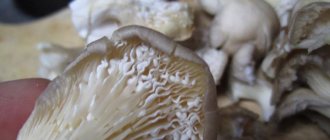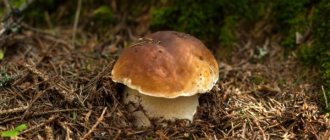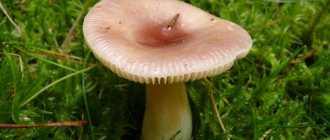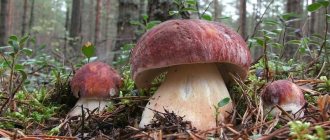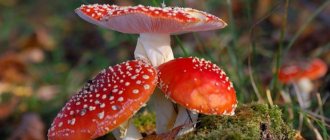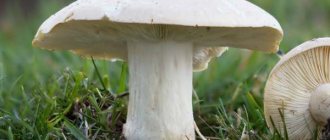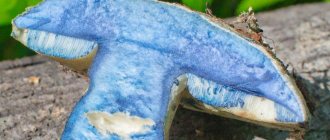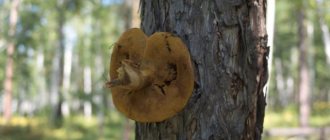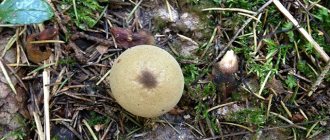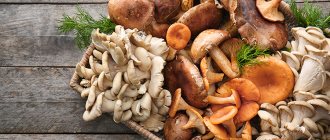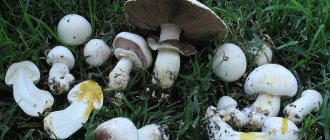Why does a white coating appear on honey mushrooms?
Reasons why there is a white coating on fresh honey mushrooms in the forest
Sometimes, when going for the next mushroom harvest, you can notice a white coating on honey mushrooms in the forest. Some people immediately reach a dead end, not knowing what this feature is and what it can mean for their health. As a result, many pass by fruiting bodies with similar signs. However, let's try to figure out why a white coating appears on honey mushrooms and what can you do if you encounter them on your way? It must be said that even in case of the slightest doubt, you should avoid such a mushroom so as not to expose yourself and your loved ones to danger. Indeed, sometimes these features hide false representatives posing as edible honey mushrooms.
Often the white coating on the caps of honey mushrooms is spore powder, which many can mistake for mold. However, here you will need to take into account some points. In fact, spore powder in the form of a white coating is absolutely harmless. Most often, this feature is found in overgrown honey mushrooms. With age, these fruiting bodies lose a number of properties inherent in their smaller “brothers”. So, in mature large honey mushrooms, the cap straightens out and takes the shape of an umbrella. In addition, the scales and “skirt” around the stem of such mushrooms disappear with age. Instead, a white coating appears, which can scare novice mushroom pickers. However, as already mentioned, this characteristic does not cause any harm. Of course, not all lovers of “quiet hunting” take overgrown honey mushrooms into their baskets. However, some do not refuse such mushrooms, provided that its external characteristics and the quality of the pulp are not inferior to young individuals. In this case, the plaque is removed with an ordinary dry kitchen sponge.
But how do you understand that the white coating on fresh honey mushrooms is not mold? It’s very simple – you need to smell the picked mushroom. The usual spore powder on the surface of the honey fungus emits a pleasant forest aroma, and the mold smells accordingly. Therefore, if your sense of smell suggests that you are holding in your hands a completely normal and fragrant honey fungus, despite the presence of plaque, you can safely put it in the basket. However, if the mushroom smells unpleasant, it is better to leave it where it grows.
Sometimes mold actually appears on young fruiting bodies, but this does not scare some experienced mushroom pickers. If the mold appears partially, then such mushrooms are considered completely edible. First, you should carefully examine the fruiting body. If the white coating on honey mushrooms is located only on a small area of the cap, then it can be cut off with a knife when you come home. Although it will be better if this procedure is carried out right in the forest. Also, look carefully under the mushroom cap. If the plates in this area are affected by mold, then the mushroom should be thrown away.
It is also worth noting that there are also false honey mushrooms with a white coating on the cap. In this case, your sense of smell and knowledge of the distinguishing features of an edible mushroom from its false counterpart will again help you. If you are not sure that this is an edible honey fungus, then it is better to pass by.
To be sure, when you get home, boil the fruiting bodies by putting 1 peeled onion in a saucepan. This is a very effective and efficient “detector” of poison. If the vegetable turns blue during cooking, it means you have picked up false mushrooms.
Do you need to know the signs of poisonous mushrooms?
No less ridiculous and dangerous are the beliefs of some optimistic people who believe that poisonous mushrooms are rare, so you shouldn’t bother yourself with their distinctive features. In fact, about 90 of these species can be found in our forests, and about 10 of them are fatal to us.
Of course, this does not mean that in order to avoid mushroom poisoning, you need to buy them only in grocery stores. The purpose of this article is to show the reader the importance of knowing not only tasty and edible species, but also the signs by which they can be distinguished from their poisonous counterparts.
What to do if home-picked milk mushrooms become covered with a white coating?
For several years now in the fall, my relatives have treated me to a jar of salted milk mushrooms. These are white milk mushrooms, salted in the usual cold way in a tub and transferred especially for me into a glass jar.
Since I am not a particular fan of milk mushrooms, I don’t eat them right away, and this jar continues to be stored in the refrigerator for some time.
But over time, a white coating begins to form on the surface of the mushrooms, and even the brine itself in the upper part of the jar becomes whitish-cloudy.
If anyone knows, tell me what it is? Mold? Or discharge from the garlic used in salting? And can such mushrooms be eaten?
Yes, the white coating in salted mushrooms is mold, but you shouldn’t throw away such mushrooms, you just need to rinse them in running water and you can safely eat them or (if there are a lot of mushrooms) replace the brine in them.
I myself don’t particularly like salted mushrooms, but we buy saffron milk caps and milk mushrooms for my husband, he likes them salted. He salts himself and doesn’t let me near him. If such a white coating appears on the milk mushrooms when they stand for a long time, then the husband simply washes the milk mushrooms and eats quietly. He believes that there is nothing special, the coating is not harmful.
I used to worry, I even tried to throw out the milk mushrooms that had a white coating, but now I treat them with understanding, it’s okay. Yes, and in the village I had to see this with my relatives; my aunt also washed milk mushrooms before cutting the mushroom salad. This plaque is harmless, but you just don’t want to eat it.
Oh, how I envy you) There have been no salted milk mushrooms on our table for several years now. I can give you some advice - to prevent this embarrassing film from forming, place a leaf of horseradish on top, and then change it after a while. If there is no horseradish leaf, you can sprinkle mustard (ordinary powder) on top, and then simply remove the top mushroom along with the mustard. Once upon a time, our neighbor poured vodka over mushrooms in a jar and said that it helped with long-term storage. They also put a clean cloth on top, then throw it away. Sometimes the brine is drained and refilled with new brine.
And before eating, just rinse the mushrooms with water if mucus has formed. After all, the jar contains organic matter). They can also be used after heat treatment, for example, in a pie with potatoes or sauerkraut and milk mushrooms.
Much depends on storage conditions
It is correct to store salted mushrooms in a cool, well-ventilated place, where the mark on the thermometer does not rise above +1, +3 degrees. If the temperature is lower, the mushrooms will freeze and lose their taste, and in excessive heat (above +6 degrees) they will sour.
After finishing the salting, it is better to put the mushrooms in jars, put the spices from the bucket on top and cover with lids. The jars are stored well in the refrigerator at a temperature of +5, +8 degrees.
If mushrooms are pickled directly in jars, you should not cover them with lids, only with a cloth. To allow air to enter, densely packed mushrooms are pierced with a stick to the very bottom, like sauerkraut. With access to air, the development of botulism is impossible, which is very important when preparing products that have come into contact with the ground.
A wooden barrel or enamel bowl is more suitable for pickling mushrooms. You also need a dark, cool place where the mushrooms will stand throughout the pickling period.
In hot weather, if there is no cellar and there is no cool place in the house, the hot salting method is most relevant. When cold salting, there is a high probability that the mushrooms will sour even at the stage of soaking in cold water.
That time, when our mushrooms turned sour, we did hot pickling .
Honey mushrooms are covered with a white coating: what does it mean, is it possible to eat?
A white coating on honey mushrooms may appear after collection or during canned storage. Sometimes in the forest there are mushrooms covered with a white coating. Experienced lovers of “silent hunting” know what to do with such honey mushrooms, but for beginners this raises many questions.
What does the white coating on honey mushrooms mean?
White plaque on the caps of fresh honey mushrooms is not always a sign of the development of pathogenic microflora. Sometimes it is associated with the characteristics of mushroom growth in the forest. If plaque appears on honey mushrooms that have already been collected or preserved, then urgent measures need to be taken, otherwise the entire preparation will have to be thrown away.
White coating on honey mushrooms in the forest
Having noticed autumn mushrooms covered with a white coating in the forest, many mushroom pickers try to avoid them. This is justified by concern for one’s safety; false doubles may be hiding behind such copies.
Often the white coating on the caps of honey mushrooms is spore powder; it is harmless to health. But more often this feature appears in large specimens, with a straightened umbrella-shaped cap. Experienced mushroom pickers do not refuse large, mature mushrooms if their pulp is not inferior in properties and appearance to young ones. You can wipe off such deposits at home with a dry kitchen sponge.
You can collect honey mushrooms with a white coating if they have a characteristic mushroom aroma, and the spore powder gives them a strange whitish color.
The moldy yellow coating on honey mushrooms is easily distinguished by its characteristic, unpleasant odor. If most of the cap and stem are covered with mold, such samples cannot be collected in the basket. They have accumulated dangerous toxins that can cause severe poisoning.
White coating on honey mushrooms in a jar
After pickling mushrooms, a white coating sometimes appears on the surface of the jar. This is not mold, but kahm yeast, it is not harmful to health. If the lid does not close the jar tightly, the brine or marinade evaporates, and the surface of the mushrooms is covered with a white coating.
The situation can be saved only if the start of the process is noticed on time. The specimens covered with plaque are thrown away, the remaining ones are washed, boiled for 5-10 minutes, and filled with fresh brine, increasing the salt concentration. The preservation is placed in clean, sterilized jars, and after cooling, stored in a dark, cool place.
To prevent a white coating from appearing on the plates in a jar of salted honey mushrooms, use a cotton cloth soaked in vodka. It is used to cover the surface of preserved honey mushrooms. The jar is filled tightly so that there are no gaps or air spaces between the mushrooms; this is where mold begins to grow during storage.
If after a while a white coating appears on the surface of the rag, you need to throw it away, take a clean cloth soaked in vodka, and wipe the coating off the edges of the jar with a sponge. Cover with a clean cloth, put pine chips as a binder, and add a little brine (1 tablespoon of salt per 1 liter of water). The brine should cover the product by 1-2 cm. Then close with a tight lid. It is also advisable to soak it in vodka.
In what forests is this species found?
The autumn honey fungus can be considered a cosmopolitan of our latitudes. It can be found in almost any forest that is more than 30 years old. Honey mushrooms grow on more than 200 species of trees. As a rule, these fungi appear in colonies on dry trunks, dead wood, stumps, roots and trunks of living plants. Most often, honey mushrooms are found on spruce and birch trees, a little less often they can be found on pines, aspens and oaks. Tree mushrooms are the orderlies of temperate forests. When they settle on dead wood, they destroy it. At the same time, the valuable elements from which it consists are returned to the biological cycle of substances. In the same place, autumn honey mushrooms can be collected for up to 15 years in a row. After this period, the wood is completely destroyed by mycelium.
Autumn honey mushroom colonies grow very abundantly. From one stump you can collect several liters of these valuable mushrooms. Young honey mushrooms with an unopened cap are collected together with the stem. Only the caps of grown mushrooms are cut off. Their legs have no nutritional value.
There are many recipes for preparing these mushrooms. Honey mushrooms can be boiled, pickled, dried and salted, as well as fried. When picking mushrooms, you do not need to pull out their stems from the wood “by the roots”, so as not to damage the mycelium, which will delight you with a bountiful harvest next year.
Is it possible to eat oyster mushrooms with a white coating?
Oyster mushroom is a tasty dietary mushroom that perfectly reveals its flavor potential in combination with other products. The presence of white coating (or mold) is not hazardous to health if the cooking regime is followed correctly.
Choice when purchasing
First of all, when purchasing, you should inspect the mushroom for damage. It should have a generally good shape, white color without yellow spots . The presence of cracks, wormholes, even small ones, indicates that the product is not fresh.
The next thing you should pay attention to is the length of the leg. Not all buyers are aware of this nuance, and it becomes clear why this happens. Some people enjoy the specific flavor texture of the drumstick, while others take it for granted. Ideally, the stems should be cut off or very short, as this part of the oyster mushroom contains few nutrients and has a harsh taste.
You need to choose young mushrooms. To determine the age, just break off a small piece from the cap. The presence of white and juicy pulp confirms the freshness of the mushroom, and if the structure is fibrous, then this mushroom is stale and should not be purchased.
Causes of plaque
In fact, this is not plaque or mold, but mycelium (mycelium). These thin white threads appear for a rather banal reason - an increase in temperature. This can even happen in the refrigerator. But there is no reason to worry: the appearance of mycelium does not entail danger and does not in any way change the taste of the product. But there are other types of mold, and they are all dangerous.
The appearance of mold with a black, pink, green tint, which is accompanied by an unpleasant, woody, sour odor, signals improper storage and the danger of poisoning. And it’s better to get rid of such a fruiting body.
Is it possible to eat
The mycelium is not harmful to health and tastes like a mushroom. It also does not spoil the taste of the oyster mushroom itself. You can play it safe and rely on your sense of smell - if the appearance of these white threads is not accompanied by a sharp and unpleasant odor, and the product has a characteristic mushroom smell, then the mushroom is edible and safe for health. As a last resort, this plaque can simply be cut off.
How to process
To prepare a delicious dish, you should carefully go through the next step. At the beginning, the product should be carefully cleaned of dirt. Next, wash it and give time for the water to drain. Then the mushrooms must undergo thorough heat treatment. It is enough to cook for 15–25 minutes, depending on the size of the product. Fry for 15 minutes.
With low heat treatment, the aromas will be soft, with high heat treatment they will be enhanced. Simmer over low heat for no more than 20 minutes. Before salting and pickling, it is also necessary to boil the oyster mushrooms. It is sometimes used as a seasoning, which has a sweetish taste, by drying and grinding.
How to store
Oyster mushrooms, like all mushrooms, are a perishable product. Over time, it can become covered not only with mycelium, but also with other dangerous types of mold.
To keep the harvest fresh, you must follow the storage rules:
- no more than a day at room temperature;
- up to seven days at temperatures from 0°C to +7°C;
- up to two months - from -2°C to -4°C.
If you do not plan to eat it immediately, then the delicacy should be frozen in the freezer at -18°C and kept for storage in the refrigerator or basement. This will allow it to retain its beneficial properties for up to 4 months. And if you boil the product in salt water before freezing, the harvest will remain fresh for another six months.
It is important to take into account the recommendations on how to store a jar of salted or pickled mushrooms. The idea is simple: you need to take an ordinary piece of fabric, about 20x20 cm, and completely soak it in vodka. A cloth soaked in vodka is placed inside the jar directly on the mushrooms. Vodka has no effect on the taste of oyster mushrooms. The jar is closed with a lid and transferred to a storage location. Thus, the product can be stored for up to three weeks.
Oyster mushroom is deservedly a nutritious and popular product, even despite the presence of terrifying white mold. Those who are familiar with this feature are no longer afraid of it and simply enjoy the taste. Well, everyone else needs to be attentive to various changes in this delicacy, take care of their health and consult with specialists.
How to properly sterilize jars and lids before screwing
Improper sterilization leads to spoiled workpieces.
All components and ingredients must be clean so that microorganisms do not get into the preparation for the winter:
- Check jars and lids for chips and scratches.
- Prepare all ingredients thoroughly.
- Sterilization time depends on the size of the container: 1–2 liter jars are exposed to steam for 10–15 minutes. A three-liter bottle takes 20–25 minutes.
- Allow sterilized jars and lids to dry.
Features of storing pickled cucumbers
After you have made the twists and checked for leaks, turn them over and place them on the lid for a more complete fit. To increase the heat treatment time, the preservation is wrapped and left to cool gradually. After a day or two, the workpieces should be placed in a cool, dark place. The ideal option is a cellar.
There are several effective folk methods for extending the “life” of conservation, guaranteeing the absence of mold.
They say that mold will not appear if you add:
- Mustard powder. Place mustard plaster under the lid (you can place mustard powder in a piece of fabric) and close.
- Black peppercorns. Place the pepper in the bag in the brine.
- Adding a teaspoon of mustard powder or peppercorns directly to the brine will also extend the shelf life.
- The optimal temperature for storage is from –1°С to +1°С. The higher the temperature, the faster bacteria develop and the cucumbers become unusable.
Video: To prevent pickles from molding
To summarize, we can summarize - to prevent your cucumbers from becoming moldy, you need to follow the canning rules and shelf life. White plaque is formed as a result of the activity of microorganisms.
Brick-red false honey fungus
Important! The main difference between honey mushrooms and false honey mushrooms is the presence of a ring on the stem.
Brick-red false honey fungus
The main difference between a false foam and a real one is the cap. It is spherical in shape, rich brick red in the center and lighter at the edges. Like all twins, the cap is smooth and dry.
The leg inside is empty, thin and smooth, with time – with a bend. If you break the stem, the mushroom will begin to emit an unpleasant odor, but real mushrooms have a pleasant, mushroom aroma. Inside the cap there is a cobwebby blanket, over time it will hang from the edges.
The plates on the inside change color from yellow to dark brown. Brick-red honey fungus grows exclusively on rotten stumps and fallen trees; common places include birch, alder, and aspen. And sometimes these mushrooms are found on wooden fences.
The growth time of brick-red honey mushrooms is the same as that of autumn honey mushrooms - from the end of August until the appearance of the first snow.
Did you know? Seroplate false honey fungus is considered an edible mushroom. It doesn't taste bitter.
It is used in the preparation of first and second courses and eaten boiled.
The mushroom cap is thin, light yellow in color with a tubercle in the center. The diameter of the cap is from three to eight centimeters.
The leg is also thin, with a bend. Above it is lighter, yellowish in color, below it is darker - rusty brown. The color of the plates of the sulfur-plated false foam is from light yellow to gray-brown. This mushroom grows in coniferous forests, on rotting pines.
Important! The sulfur-plated false honey fungus is similar to poisonous mushrooms of the same family, which are called sulfur-yellow false honey fungus. They are distinguished by the plates of a sulfur-yellow mushroom, which are green in color.. Did you know? Watery fungus is also called Psatirella watery.
Did you know?
Watery fungus is also called Psatirella watery.
The leg is tall and smooth, white, up to eight centimeters high and half a centimeter in diameter. This mushroom also has a false ring at the top of the stem. The young mushroom is distinguished by light plates, which acquire a brown tint over time. The habitats of this false honey are deciduous and coniferous forests.
Important! Watery fungus is considered neither a poisonous nor an edible mushroom.
similar to many types of honey mushrooms: summer and autumn honey mushrooms, and gray-plated false honey mushrooms, which are considered edible.
But the sulfur-yellow honey mushrooms themselves are
poisonous mushrooms
.
The cap of this type of mushroom is smooth and without scales. It has a bell shape, which becomes flatter over time. The edges seem to be bent inward. The color of the cap corresponds to the name of the mushroom, and at the edges the shade is lighter.
The color of the plates is olive-black. The leg is tall, up to nine centimeters in length, cylindrical in shape, with a diameter of up to one centimeter. The mushroom, if cut, has an unpleasant odor, the color of the flesh is sulfur-yellow, and has a fibrous consistency.
Also called Psatirella Candolla
. The mushroom grows from early May to early autumn. Lives in parks, vegetable gardens, mixed and deciduous forests.
You can distinguish this type of honey mushroom from others by the white and white-yellow-brown color of the cap. The hat, like the previous species, has a bell shape, which evens out over time, but there is still a small protrusion in the center.
Along the edges of the cap hang the remains of a blanket that looks like a cobweb. The diameter of the cap is from three to seven centimeters. A young mushroom has grayish plates, while an adult has dark brown plates, which also grow to the stem.
The leg is white-cream in color with fluff at the bottom. The length of the leg reaches seven to ten centimeters. As soon as summer comes, Candoll's false honey fungus competes with another type of dangerous mushroom - the flickering dung beetle. The first grows in the shade, the second in the sun.
Important! The Psatirella Candolla mushroom is very cunning! Its appearance is influenced by everything - air temperature, humidity, age of the mushroom, habitat. Therefore, only an experienced mushroom picker can distinguish these mushrooms from edible mushrooms.
Honey mushrooms autumn beneficial properties of autumn honey mushrooms, types of autumn honey mushrooms
In terms of calorie content, honey mushrooms are not inferior to boletus mushrooms; in addition, their pulp has a very pleasant taste and smell. They can be used for food in fried, boiled, salted and pickled form.
Among autumn honey mushrooms, experts distinguish three subgroups: true autumn honey mushrooms, tuberous or bulbous autumn honey mushrooms
and
late-form autumn honey mushrooms
.
Real autumn honey mushrooms
True autumn honey mushrooms have a cap 3–10 cm in diameter; at first it is round-convex, but later it becomes flat, sometimes exhibiting a small tubercle in the middle.
The color of the cap changes depending on weather conditions: in dry weather it is yellow-brown, and in damp and cold weather it is dark brown (but numerous brown scales are always present). Records of autumn real mushrooms
sparse, adherent, slightly descending along the stem, thin, frequent; in young mushrooms they are light yellow, and in old ones they are brown with brown spots.
Leg of real autumn honey mushrooms
has the same color as the cap. In appearance it is long and very thick (can be up to 1.5 cm thick), and its structure is dense. At the top there is a ring with a fringed edge, which is generally not edible due to its structural properties.
Pulp of autumn real mushrooms
thin-fleshy, dense, white, does not change color when cut, and during cooking it acquires a pleasant taste and smell.
Season for collecting real autumn honey mushrooms
falls in August-September.
Autumn honey mushrooms are tuberous or bulbous in shape
The size of the cap of autumn tuberous mushrooms
matches the cap size of real honey mushrooms.
Its distinctive characteristic is its fibrous structure and yellow-brown or creamy-brown color. (Note: in dry weather, the color varies from light yellow to yellow-brown, and in damp or cold weather the cap of the mushroom turns intensely brown.) The plates of tuberous mushrooms
slightly descend along the stem, they are thin, not very frequent, in young specimens they are light-colored. yellow, in mature ones – yellow-brown.
The leg of autumn mushrooms is tuberous in shape
has the same external properties as the leg
of autumn honey mushrooms
. True, unlike the latter, it is highly fibrous and significantly expanded at the base, so that it really resembles a tuber or a young onion.
In the forest, honey mushrooms are tuberous or bulbous in shape.
can be collected: in August-October.
Autumn honey mushrooms of late form
The first distinctive feature of the cap of these mushrooms is a sharp tubercle in the middle: so that in cross-section it very much resembles a triangle. The second feature is the double color of mature mushrooms: in the middle the cap is brownish-brown, and at the edges it is creamy brown.
Autumn honey mushroom plates
have slightly descending stems, adherent, thin, medium frequency. In young mushrooms they are light yellow, while in old ones they are brownish, often covered with brown spots.
The stem of these honey mushrooms is slightly inferior in thickness to the previous species. Its color is cream or yellow-brown; whitish scales are visible on the surface.
In the forests, late-form autumn honey mushrooms
They meet somewhat later than their “brothers”: in September-November.
Compiled by I. Egorova (aka_silikus)
Collection of forest gifts
The autumn month is rich in forest gifts. What specimens can you find when you come to the forest?
Porcini
At the beginning of the month, boletus mushrooms are noticed, which live in spruce and pine forests. Moreover, porcini mushrooms grow longest in October in pine moss forests. Their development resumes after frosts pass, but the specimens freeze severely. Such a mushroom, diluted with water, is suitable for consumption. Boletuses are becoming increasingly rare in the fall, but they can actually be found in sunny meadows.
Butter
The late oiler, which has a membranous ring on the stem, also prolongs its growth. Externally, it is a mushroom with a 12-centimeter cap and a tubercle in the center, brown in color. It has dense yellow flesh, the skin peels off easily and sticks to your hands. The leg is medium, smooth to the touch, solid. The oiler's habitat is pine forests.
Black milk mushrooms
It is possible to find a black milk mushroom. It is found in mixed forests. The breast is dark greenish in color, with a hollow, small stem. He hides under withered leaves. When you find one, you can also find neighbors. If you salt it, it will have a great taste and a dense texture.
Umbrella mushrooms
Sometimes you can find a mushroom delicacy - this is a variegated umbrella. Of course, in October it is of a different variety and is presented as a blushing or shaggy umbrella.
Chanterelle
The mushroom grows until late frosts. Its color is like the yolk of an egg. The continuous stem flows smoothly into the hat. Young chanterelles have a convex cap, while more mature ones have a funnel with wavy borders on it.
Saffron milk caps
The saffron milk caps continue to grow in the fall. It doesn’t end even after frost. In summer and in the first month of autumn, the mushrooms are damaged by moss, but in October they are clean and have a dense structure. Habitat: pine and spruce forests.
Bitters
Pine and mixed forests in the fall are rich in the harvest of bitters, which do not die after the first frost. The mushroom has a red-brown color, a funnel-shaped cap with dry skin. Bitters produce white, bitter, acrid juice, so they need to be soaked for a long time, constantly changing the water. They are often salted.
Rows
Reddened row crowded is a little-known mushroom. The variety loves mixed forests and grows where there is a lot of sawdust. The row is found on pine stumps throughout the entire half of October. By the end of the month it disappears. These specimens always grow in a dense, large family. Harvest - about 100 pieces. The variety has smooth, dry skin. The hat is brown with a dark shade in the center. Small mushrooms with wide plates are white, mature mushrooms have a yellow tint.
There are also other varieties of rowing, which are very common after October 15th. Some of them tolerate cold well, so they can be collected until the end of the year.
If the frost hits lightly, the rows of gray and green species are not afraid of it, sticking out their caps from under the pine needles, the mossy area among the pines, from the sandy ground.
These are the same mushrooms that can be purchased on the market, only wild ones. Oyster mushrooms often have a very rich gray tint compared to self-grown specimens. They grow towards the end of October and are located on dead tree trunks.
greenfinch
This type of mushroom can be found throughout October. Their habitat is pine forests and beaches. Greenfinches are tasty, have pale yellow flesh, with green skin and a dark center. The leg is low, solid, yellow in color, almost always completely covered with sand. The greenfinch's hat is convex and has waves along the edge. After cooking, the green color of the mushroom remains.
Honey mushrooms
The productivity of honey mushrooms is in 1st place compared to other mushrooms. They are found near the most unpredictable places. More often these are fallen deciduous trees and stumps. Honey mushrooms grow thickly. They can even stick to an old stump.
How to remake salted milk mushrooms. Cold salting of milk mushrooms
Fragrant, strong, crispy - this is how cold-salted milk mushrooms turn out.
It is named so because the mushrooms are not thermally processed and are salted in a cold place. And in order to wait for the snack to be ready (a month or a month and a half), you need to have a cold exposure.
Salting milk mushrooms coldly at home requires a large container, ideally a wooden one, but a barrel or tub can be successfully replaced by an enamel pan (without defects) or a stainless steel basin. It is not recommended to take aluminum containers.
For 1 kg of milk mushrooms you will need 30-40 g of salt + a set of seasonings: horseradish root and leaves, peppercorns, garlic, currant leaves, dry dill umbrellas.
At the bottom of a clean and dry container, form a “pillow” of aromatic leaves, horseradish roots, peppercorns, and add some salt. Milk mushrooms are placed on top - densely, one to one, with caps down.
Each formed layer is sprinkled with salt and spicy additives. The workpiece is covered with horseradish and currant leaves.
In order for the pickling of raw milk mushrooms to go as planned, close the container on top (for example, with a plate of a suitable size) and apply pressure.
It is important to choose the right weight. To do this, the next day after adding all the ingredients, estimate the amount of juice released - it should cover the contents of the container. If there is not enough liquid, add heavier pressure.
The workpiece is sent to a cool place or in the refrigerator for a month and a half.
Salting milk mushrooms using this method allows for the addition of new portions of the mushroom harvest to the formed preparation (if the size of the container allows).
Cold salting of black milk mushrooms is no different from the preparation of their white “brothers”, except for a longer period of preliminary soaking. When ready, nigella acquires a beautiful “wine” hue, perfectly preserving its taste and aroma during storage.
When cold salting of milk mushrooms is completed, for convenience, the finished mushrooms can be packaged in jars, covered with lids (do not roll them up!) and kept in the refrigerator.
